Ladies and Gentlemen: Good morning!
I am very glad to meet you at the beautiful city of Bologna for the 2024 seminar of ADI, as it is dedicated to the transformation of education and teacher’s roles in the era of artificial intelligence. Both resonate deeply with our times and have global significance.
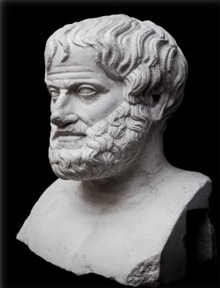 In the afternoon session yesterday, Ilaria Gaspari mentioned the philosophical ideas of Socrates, which sparked lively discussion among us. In line with the theme of the seminar, I would like to draw your attention to Socrates’ pedagogy that dated back to almost 2500 years ago. When teaching, he would always engage students in questions rather than telling students the answers. If their responses were incorrect, he would ask further questions to guide them towards more and deeper thinking and correct answers. He thus called his teaching method “midwifery”, reportedly inspired by his mother’s profession as a midwife. Just as a midwife helps a woman give birth to babies, Socrates believed that his approach could help people “give birth to” correct ideas.
In the afternoon session yesterday, Ilaria Gaspari mentioned the philosophical ideas of Socrates, which sparked lively discussion among us. In line with the theme of the seminar, I would like to draw your attention to Socrates’ pedagogy that dated back to almost 2500 years ago. When teaching, he would always engage students in questions rather than telling students the answers. If their responses were incorrect, he would ask further questions to guide them towards more and deeper thinking and correct answers. He thus called his teaching method “midwifery”, reportedly inspired by his mother’s profession as a midwife. Just as a midwife helps a woman give birth to babies, Socrates believed that his approach could help people “give birth to” correct ideas.  Today, with the breakthroughs of generative artificial intelligence technologies such as ChatGPT, the ideal of Socratic teaching is becoming more and more attainable. Perhaps we may just as well reverse the title of this session, and make it “From Artificial Intelligence to Socrates”. That is, we may be justified to talk about how the latest technologies can facilitate the realization of education ideals.
Today, with the breakthroughs of generative artificial intelligence technologies such as ChatGPT, the ideal of Socratic teaching is becoming more and more attainable. Perhaps we may just as well reverse the title of this session, and make it “From Artificial Intelligence to Socrates”. That is, we may be justified to talk about how the latest technologies can facilitate the realization of education ideals.

At the beginning of yesterday’s session, the ADI chairperson raised an essential question: what motivates our commitment to education? She answered that it lies in education’s significance. I agree with her. So what makes education meaningful?
In my view, the meaning of education resides in the fact that humans become civilized through education. Biological evolution is very slow. Given roughly similar environments, the wild animals born today have no essential difference in survival mode from their ancestors ten thousand years ago. Genetically, the intelligence of modern human individuals is not much different from that of their ancestors thousands of years ago and their physical strength may have even degenerated due to their separation from the wild survival environment. Yet culturally, today’s humans are not only different from humans 10,000 years ago, but also significantly different from humans a millennium ago, a century ago, or even two decades ago. The reason behind such transformations lies in the iterative development of human cognition based on intergenerational transmission and the communication and collaboration of groups, which all stem from education! Therefore, it can be said that humans become civilized through education.

Another aspect that highlights education’s significance is that it sows the seeds for solving tomorrow’s challenges. My team and I come from the China National Academy of Educational Sciences (CNAES). It is a top educational research institution and thinktank. Last month, we released the Report on Global Trends of Basic Education Innovation and the Global Digital Education Development Index (GDEI). Based on our research and the evidence database encompassing the digital education developments in various countries, we identified eight trends of innovation in basic education around the world in the digital era, formulated the digital education development index for 62 pioneering countries as well as analytical reports by countries, and articulated our findings and reflections on the digital transformation of education and its implications for teacher development. Next, on behalf of my team, I would like to share some of our perspectives on the theme of today’s session.
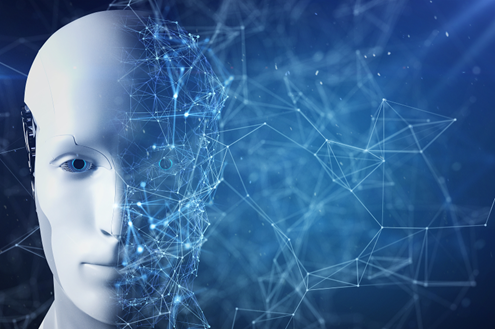
Nowadays, a new round of revolution in science, technology and industries is reshaping the innovative development map of the world, and remodeling the global economic structure. Chinese President Xi Jinping noted that artificial intelligence is the strategic technology ushering this revolution and has a “head goose” effect, as its development can lead and drive the progress of other technologies and industries.
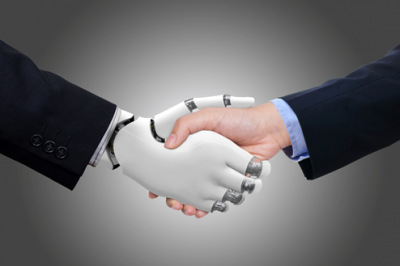 In November 2022, the release of ChatGPT set off a worldwide AI craze. As a generative artificial intelligence application, ChatGPT leverages powerful natural language processing capabilities to complete various complex tasks, such as answering questions, writing poetry and code. For the first time, an AI system exhibits “emergent” qualities through multimodal processing of text, images, audio, and video. This context suggests that education and classrooms will undergo major transformations. The collaboration between human teachers and machine teachers will become the new norm for future education. Many Chinese companies are heavily investing in AI to accelerate applications for education.
In November 2022, the release of ChatGPT set off a worldwide AI craze. As a generative artificial intelligence application, ChatGPT leverages powerful natural language processing capabilities to complete various complex tasks, such as answering questions, writing poetry and code. For the first time, an AI system exhibits “emergent” qualities through multimodal processing of text, images, audio, and video. This context suggests that education and classrooms will undergo major transformations. The collaboration between human teachers and machine teachers will become the new norm for future education. Many Chinese companies are heavily investing in AI to accelerate applications for education. 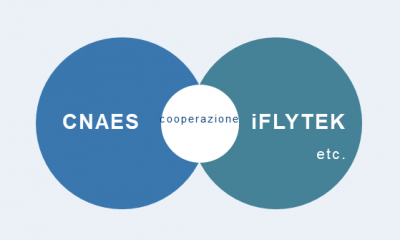 Recently, the China National Academy of Educational Sciences has signed a cooperation agreement with a top AI company in China to jointly develop a composite intelligent teacher mechanism incorporating human teachers and machine teachers via generative AI, high-quality educational data and large-scale organized deployment. It structures the educational wisdom of human teachers, calibrates the professional ability of the machine teachers, and constructs a safe, public, controllable, and high-quality educational large model. The system will support human teachers with AI-empowered machine counterparts. This new paradigm will open up new vistas for digital education and a new track of teacher education.
Recently, the China National Academy of Educational Sciences has signed a cooperation agreement with a top AI company in China to jointly develop a composite intelligent teacher mechanism incorporating human teachers and machine teachers via generative AI, high-quality educational data and large-scale organized deployment. It structures the educational wisdom of human teachers, calibrates the professional ability of the machine teachers, and constructs a safe, public, controllable, and high-quality educational large model. The system will support human teachers with AI-empowered machine counterparts. This new paradigm will open up new vistas for digital education and a new track of teacher education.
In the context of digital transformation of education, human teachers will not lose their jobs, but will augment their roles in collaboration with machine teachers. 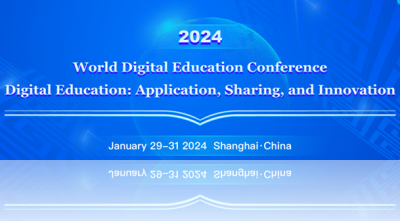 Last month, the 2024 World Digital Education Conference in Shanghai saw lively discussion on the digital transformation of teaching roles by participants from all over the world. It is generally believed that teachers will transform from “gatekeepers of knowledge” to “choreographers of learning”, paying more attention to guiding student emotions, attitudes, and values while gradually becoming producers of knowledge, facilitators of learning, and guides for growth.
Last month, the 2024 World Digital Education Conference in Shanghai saw lively discussion on the digital transformation of teaching roles by participants from all over the world. It is generally believed that teachers will transform from “gatekeepers of knowledge” to “choreographers of learning”, paying more attention to guiding student emotions, attitudes, and values while gradually becoming producers of knowledge, facilitators of learning, and guides for growth.  Whitehead (1967) “[laid] it down as an educational axiom that in teaching you will come to grief as soon as you forget your pupils have bodies”(p.50). Sukhomlinsky(1982) also believed that teaching is not just a mechanical transfer of knowledge from one mind to another, but rather a constant emotional exchange between teachers and students. Future education demands engagement with feelings and interactivity. Future human teachers must not only coexist with machines but also lead machines to work for them. Future human teachers must work empathetically, learning to enter students’ spiritual world, and elevate their pedagogy into an art.
Whitehead (1967) “[laid] it down as an educational axiom that in teaching you will come to grief as soon as you forget your pupils have bodies”(p.50). Sukhomlinsky(1982) also believed that teaching is not just a mechanical transfer of knowledge from one mind to another, but rather a constant emotional exchange between teachers and students. Future education demands engagement with feelings and interactivity. Future human teachers must not only coexist with machines but also lead machines to work for them. Future human teachers must work empathetically, learning to enter students’ spiritual world, and elevate their pedagogy into an art.  Since 2020, Shanghai’s Luwan No. 1 Central Primary School has innovatively combined digital technology and emotional education, and has achieved outstanding performance. Driven by big data and artificial intelligence, their innovation prioritizes emotional education, and widely applies digital technology to fragmented scenes of education and teaching. It improved the overall quality of students, learning interest, and the ability to integrate knowledge and action through the construction of a whole-process education mechanism of “data collection-analysis-intervention-evaluation feedback”, through the establishment and utilization of the key applications for the five pedagogical steps of preparation, teaching, homework assignment, guidance, and evaluation, as well as the teaching organization and management mechanism that is highly coupled with digitalization, and through the empowerment of teachers’ all-round development with the help of digital research projects.
Since 2020, Shanghai’s Luwan No. 1 Central Primary School has innovatively combined digital technology and emotional education, and has achieved outstanding performance. Driven by big data and artificial intelligence, their innovation prioritizes emotional education, and widely applies digital technology to fragmented scenes of education and teaching. It improved the overall quality of students, learning interest, and the ability to integrate knowledge and action through the construction of a whole-process education mechanism of “data collection-analysis-intervention-evaluation feedback”, through the establishment and utilization of the key applications for the five pedagogical steps of preparation, teaching, homework assignment, guidance, and evaluation, as well as the teaching organization and management mechanism that is highly coupled with digitalization, and through the empowerment of teachers’ all-round development with the help of digital research projects.
Human beings are civilized through education, the development of which is facilitated by advances in science and technology. Looking back through history, each wave of technological advance has revolutionized human civilization and driven educational reforms. For example, the invention of papermaking and printing disseminated knowledge more widely, while the Industrial Revolution promoted the establishment of the school education system. Similarly, the rapid rise of artificial intelligence technology has led human society into an era of intelligence driven by data, human-computer collaboration, and cross-domain integration. This is reshaping industry structures, divisions of labor, and models of talent cultivation. 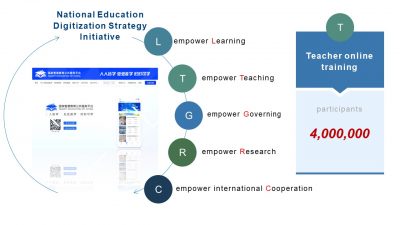 In January 2022, China’s Ministry of Education launched the National Education Digitalization Strategy, integrated existing initiatives to roll out the Smart Education of China, a national smart education public service platform. This fully empowered students’ learning, teachers’ teaching, school administration, education research, and international cooperation. Continuous progress has been made in educational transformation and innovation. As of now, over 40 million participants have taken part in the teacher training activities carried out on the platform, which has become a facilitator of teachers’ professional development.
In January 2022, China’s Ministry of Education launched the National Education Digitalization Strategy, integrated existing initiatives to roll out the Smart Education of China, a national smart education public service platform. This fully empowered students’ learning, teachers’ teaching, school administration, education research, and international cooperation. Continuous progress has been made in educational transformation and innovation. As of now, over 40 million participants have taken part in the teacher training activities carried out on the platform, which has become a facilitator of teachers’ professional development. 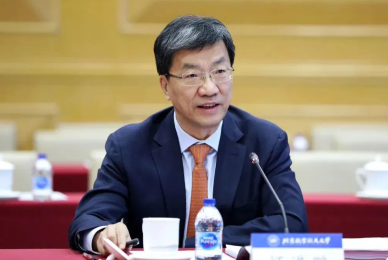 Huai Jinpeng, China’s Minister of Education, proposed that China will implement the artificial intelligence empowerment action, promote the deep integration of intelligent technology and education and teaching, use intelligent technology to assist teaching, and develop intelligent teaching assistants. This will help teachers with tasks like lesson preparation and delivery, reduce workload and improve efficiency to allow more energy devoted to creative teaching and talent education. Many schools are also actively exploring relevant practices.
Huai Jinpeng, China’s Minister of Education, proposed that China will implement the artificial intelligence empowerment action, promote the deep integration of intelligent technology and education and teaching, use intelligent technology to assist teaching, and develop intelligent teaching assistants. This will help teachers with tasks like lesson preparation and delivery, reduce workload and improve efficiency to allow more energy devoted to creative teaching and talent education. Many schools are also actively exploring relevant practices.  For example, the Zhongguancun No.1 Primary School in Beijing deployed a teaching and research platform for automatically and online recording instructional and research data. By identifying areas for improvement in teaching, supporting reflective practice, and improving teaching quality, the platform has accelerated the professional growth of many teachers. They have born witness to the renewed vitality of the teaching and research system with Chinese characteristics.
For example, the Zhongguancun No.1 Primary School in Beijing deployed a teaching and research platform for automatically and online recording instructional and research data. By identifying areas for improvement in teaching, supporting reflective practice, and improving teaching quality, the platform has accelerated the professional growth of many teachers. They have born witness to the renewed vitality of the teaching and research system with Chinese characteristics.
While AI spurs educational transformations, teaching ultimately requires human teachers, who are the magicians in schools. Looking forward, we must consider digital literacy an essential competency for teachers. It is important to focus on the promotion of teachers’ digital literacy, encourage teachers to use new technologies such as artificial intelligence and big data to innovate their classroom teaching. For this purpose, six coordinated key steps are imperative.
 First, we should envision a new approach to digital education, systematically build an empowering and data-driven relationship between education and society to benefit all learners, so that a historically comprehensive and high degree of unity between individual development at the micro level and social development at the macro level can be achieved.
First, we should envision a new approach to digital education, systematically build an empowering and data-driven relationship between education and society to benefit all learners, so that a historically comprehensive and high degree of unity between individual development at the micro level and social development at the macro level can be achieved.
 Second, we should establish innovative digital education systems that transcend the boundaries of school education and promote the integration of various education types, resources and elements. This involves harmonizing the efforts of school, parents and society in education to construct a system for high-quality ubiquitous, lifelong learning system.
Second, we should establish innovative digital education systems that transcend the boundaries of school education and promote the integration of various education types, resources and elements. This involves harmonizing the efforts of school, parents and society in education to construct a system for high-quality ubiquitous, lifelong learning system.
 Third, we should establish a new instruction paradigm of digital education, integrating physical, social and digital space, innovating teaching scenarios, promoting the human-technology fusion, cultivating learning communities that transcend grades, classes, disciplines, time and space, and realizing the organic combination of mass education and individualized instruction.
Third, we should establish a new instruction paradigm of digital education, integrating physical, social and digital space, innovating teaching scenarios, promoting the human-technology fusion, cultivating learning communities that transcend grades, classes, disciplines, time and space, and realizing the organic combination of mass education and individualized instruction.
 Fourth, we should remodel the new content of digital education, focusing on quality education, establishing knowledge graph based on systematic relationships between concepts, innovating the presentation of content, making learning an enjoyable experience, fostering higher-order reasoning skills, comprehensive innovation ability, and lifelong learning ability.
Fourth, we should remodel the new content of digital education, focusing on quality education, establishing knowledge graph based on systematic relationships between concepts, innovating the presentation of content, making learning an enjoyable experience, fostering higher-order reasoning skills, comprehensive innovation ability, and lifelong learning ability.
 Fifth, we should construct a new mechanism for the governance of digital education that is focused on digital governance and driven by digital and artificial intelligence technologies, to promote the comprehensive overhaul of education management and workflow, to improve the education governance system and raise the governance level.
Fifth, we should construct a new mechanism for the governance of digital education that is focused on digital governance and driven by digital and artificial intelligence technologies, to promote the comprehensive overhaul of education management and workflow, to improve the education governance system and raise the governance level.
 Sixth, we should explore new moral codes for digital education, ensuring that digital technologies are used ethically and safely, recognizing the opportunities and challenges brought to education by artificial intelligence, being keenly aware of the privacy, ethics, equity and safety hazards, avoiding the imbalance of education relationships caused by abuse of technologies, promoting the rational, scientific and humane development of technology application, and developing digital education with warmth.
Sixth, we should explore new moral codes for digital education, ensuring that digital technologies are used ethically and safely, recognizing the opportunities and challenges brought to education by artificial intelligence, being keenly aware of the privacy, ethics, equity and safety hazards, avoiding the imbalance of education relationships caused by abuse of technologies, promoting the rational, scientific and humane development of technology application, and developing digital education with warmth.
There is a Chinese saying that while a lone blossom may whisper spring, a hundred blooming flowers announce its arrival. We hope to work with all countries in the world to give full play to our respective strengths, sharing research findings and innovating technology application to enhance global cooperation and promote educational transformation, which may improve teachers’ digital literacy and achieve higher quality, fairer and more inclusive development of education.
Thank you!



